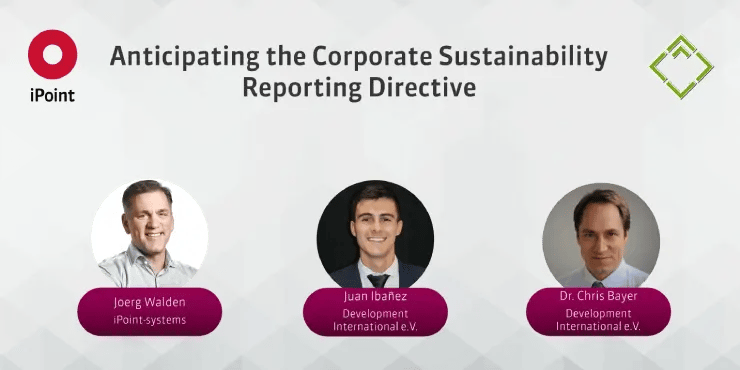A conversation between Joerg Walden of iPoint and Juan Ibañez and Dr. Chris Bayer of Development International e.V.
Joerg Walden, founder and CEO of iPoint-systems, recently sat down with Juan Ibañez and Dr. Chris Bayer of Development International e.V. to discuss the European Commission’s proposal for the Corporate Sustainability Reporting Directive (CSRD), adopted on 21 April 2021. The following conversation ensued.
Joerg: Before COVID-19 – it seems like an eternity – iPoint funded you to carry out a series of studies on the implementation of the EU Non-Financial Reporting Directive (NFRD). Your case studies for Sweden, Germany, and Austria highlighted how this legislation brought a number of advances on corporate ESG reporting, but also how it is deficient in a number of ways. Could you recap those strengths and weaknesses?
Chris: Sure thing. The NFRD was good for a number of reasons. It introduced, for the first time, the principle of mandated ESG reporting. It also introduced the double-materiality perspective – that is the requirement to report the sustainability impact to themselves and externally, e.g. the environment and society. But its strength of providing for flexibility was also a weakness: in the absence of a prescribed reporting framework, measurement methodologies, and KPIs, ESG information was often omitted, unreliable, and incomparable. Furthermore, it was not machine-readable.
Joerg: I recall: data points missing on what should be material subjects, spotty assurance underpinning the data, and incomparable disclosure because everyone was applying their own metrics and methods. Now there is an EU-led initiative to update the EU Non-Financial Reporting Directive. Tell us about it, and how ESG reporting requirements will likely change.
Juan: With pleasure. For the moment, the European Commission has put forward a proposal for the Corporate Sustainability Reporting Directive (CSRD). As with the NFRD, companies are still required to report on environmental, anti-corruption, diversity, human rights, social responsibility, and employee matters, but they have to do so in more detail, and in accordance with to-be-developed mandatory EU sustainability reporting standards. Also, the reports must be digitally tagged.
Joerg: What is meant by companies having to report “in more detail”?
Juan: “More detail” means qualitative and quantitative data, both pro- and retrospective, medium and long-term time horizons. Prospective information would include, for example, targets – in industry parlance what is referred to as “forward-looking statements”. The CSRD also features a more refined version of the double materiality concept. There are also requirements to report on a selection of topics material to stakeholders, and information relating to intangibles, for example social, human, and intellectual capital. But we need to keep in mind that the definition of “double materiality” may still change in the final version of the Directive.
Joerg: Ok. There’s lots to unpack here. Let’s drill down further on the materiality definition – given the centrality of this concept. Why and how was the materiality definition refined?
Juan: The lawmakers sought to remove “any ambiguity” that both “risks to the undertaking and the impacts of the undertaking” must be reported in the updated wording of Article 19a. Let me quote the exact wording of the definition. The requirement is to provide: “information necessary to understand the undertaking’s impacts on sustainability matters, and information necessary to understand how sustainability matters affect the undertaking’s development, performance and position.”
Joerg: One of the main challenges with sustainability reporting is that each company is its own animal. No two businesses are exactly alike, and each has their own business model. So how do you create standards for all the varied animals found in the Serengeti?
Chris: One could think of the CSRD as a framework that, inter alia, provides for the further adoption of reporting standards. In Article 19b of the proposal, the European Commission is required to adopt standards specifying “information that undertakings shall report that is specific to the sector in which they operate” by 31 October 2023. In sum, these standards will also be legally binding. The European Financial Reporting Advisory Group (EFRAG) task force – the entity charged with drafting the reporting standards – recommended that these standards should set-out sector-agnostic, sector-specific, and entity-specific disclosures. Also, SMEs would have reporting standards specific to them – but probably carry a lighter reporting burden.
Joerg: So the CSRD is the horse before the cart.
Chris: Precisely. And the cart is the future reporting standards, which will specify the particular indicators, metrics, or disclosures. The CSRD sets the direction of the caravan if you will.
Joerg: Earlier you mentioned that the disclosures would be “digitally tagged” by the company. This is long practiced in financial disclosures to aggregate.
Juan: Good point. It is long-standing practice that financial statements and management reports must be prepared in the XHTML format – a digital system that is machine readable – in accordance with the ESEF Regulation. Issuers were already required to post their entire annual financial reports in XHTML. What is new is that the CSRD now instructs you to tag sustainability information as well. The digital categorization system to be used for that will be developed together with the sustainability reporting standards. The data will then feed into the European single access point, as envisaged in the capital markets union action plan.
Joerg: One of the issues highlighted in your EU NFRD studies is spotty assurance underpinning the ESG data. The accuracy and reliability of the data is often in question. Does the CSRD address this?
Chris: Fortunately, yes. The core ESG data to be reported must be audited, at the limited assurance level. Reasonable assurance is not required for the time being so as to implement a progressive approach.
Joerg: Before discussing the required reporting content a bit more I’d like to focus on the question who is targeted by the new CSRD.
Juan: The CSRD has a larger scope of companies than the NFRD. Currently, large PIEs – public interest entities – are obliged to report. That is, non-SMEs, listed companies, for example banks, and insurance companies. The CSRD proposal extends the scope to all large companies, listed or not, and all listed companies except listed micro-enterprises.
Joerg: What does “large” mean in this context?
Juan: Companies meeting at least two of the following three requisites: 250 employees or more, 40 million euros in turnover, 20 million euros in total assets. That includes quite a bit more companies than the 500-employee threshold under the NFRD. The EU Commission’s proposal puts the number of target companies at 49,000, covering more than 75% of the EU’s combined turnover. So that is quite a jump compared with the current 11,700 subject companies under the NFRD.
Joerg: What if my company is part of a group? Am I exempt from reporting this information because that’s the job of the parent?
Juan: Well, if the subsidiary is exempt, according to the proposal, it would still have to do two things: first, publish the consolidated management report of the parent company reporting at the group level, and second, in its own management report, state that it is, as a subsidiary, in fact exempt from the disclosure requirements under the Directive.
Joerg: Let’s get back to the content of the disclosures. Could you be a bit more specific as to what would have to be disclosed?
Chris: First, the sustainability of the business model needs to be discussed. This includes its resilience, risks, opportunities, plans to ensure compatibility with Paris goals, methods to take account of stakeholder interests and, of course, how implementation is going. Second, the sustainability targets, together with the risks and principal actual or potential adverse impacts identified, as well as the actions taken to address them, the due diligence policies, and their results. The descriptions of the roles of administrative, management, and supervisory in these matters are also required. Finally, since companies would be required to report in line with mandatory sustainability reporting standards, they would need to disclose information on a number of areas: climate change mitigation and adaptation, water and marine resources, resource use and circular economy, pollution, biodiversity and ecosystems, equal opportunities and gender equality, working conditions, respect of human rights and fundamental principles, and governance factors.
Joerg: You mentioned the metrics and indicators will be featured in the upcoming standards. But do we have any notion of what they might look like?
Chris: Well, the CSRD could borrow indicators from the Sustainable Finance Disclosure Regulation (SFDR).
Joerg: I’d like to have a separate discussion with you on the related topic of the SFDR, which requires financial actors to be transparent about due diligence policies and adverse impacts in investment decisions and advice, and make sure there is no greenwashing in financial products. But let’s park that conversation for now. Back to the SFDR indicators. Can you give us some examples?
Chris: Of course. The SFDR charged the “European Supervisory Authorities” with drafting indicators, which they did. For instance, the draft defines “board gender diversity” as the “average ratio of female to male board members in investee companies.” Some other indicators proposed are the “share of securities in investments not certified as green”, the “share of investments in investee companies without any supplier code of conduct”, and the “numbers of convictions and amount of fines for violations of anti-corruption and anti-bribery laws by investee companies”. It also provides guidelines and formulas specifying what GHG emissions are and how they are calculated. Once the information is published, all these indicators will be easy to compare. The result could be a massive amount of information in the public domain.
Joerg: I remember from your studies that some national laws transposing the EU NFR Directive, such as Germany’s CSR law (CSR-Richtlinie-Umsetzungsgesetz), allowed for subject companies to report the data in a separate report. Is that still possible under the CSRD?
Chris: That option is no longer made available. The CSRD removes the possibility for Member States to allow companies to report the required information in a separate report that is not part of the management report.
Joerg: That will make comparability easier. Before wrapping up this discussion, I’d like to bring up the topic of reporting costs. It sounds like the CSRD would add implementation costs for companies. New data will need to be generated, also reaching back into the supply chains. And that data that would need to be audited.
Chris: The European Commission admits that there will be an increase in reporting costs. The official impact assessment estimates an annual cost of EUR 3,600 million, plus another EUR 1,200 million in one-off costs. But the lawmakers believe that the costs from not passing this regulation would be even greater in the medium to long-term, due to a variety of inefficiencies: apart from the headache for companies to have uneven reporting demands placed on them by from various stakeholders, including customers, suppliers and investors, many companies to not know what information they should report, not to mention their own difficulties in obtaining supply chain information for their own needs. Lastly, for companies who want to cut through the ESG noise, the current environment is not enabling. In sum, the symmetry of ESG information will be greatly enhanced through the CSRD.
Joerg: Thanks, you answered my next question on the CSRD’s main upsides for a subject company. In closing, when will the CSRD come into effect if passed?
Juan: The Directive is due to become effective in the financial year of 2023. EU-wide transposition of the Directive is expected by December 1, 2022. The first tranche of Sustainability Reporting Standards is scheduled for release by September 2022, and the second set is scheduled for release by September 2023.
Joerg: Great! That wraps up our discussion perfectly. Thanks, guys!
Chris: Our pleasure.





